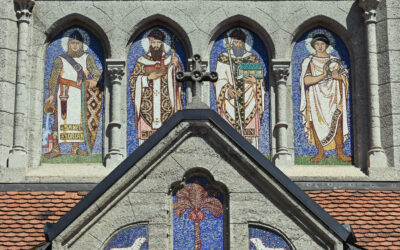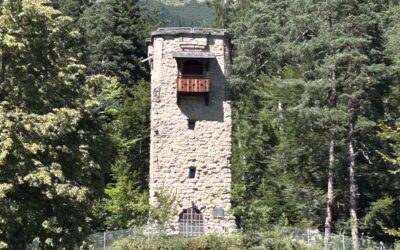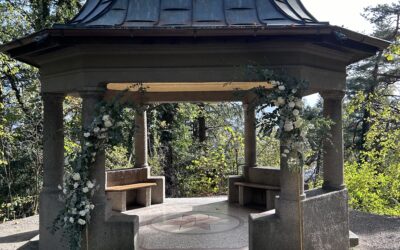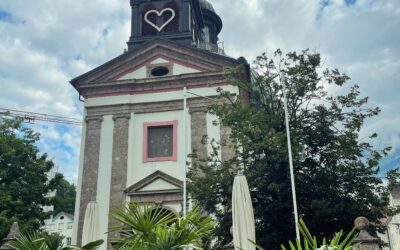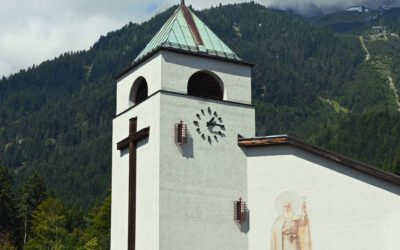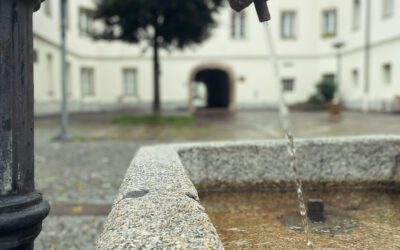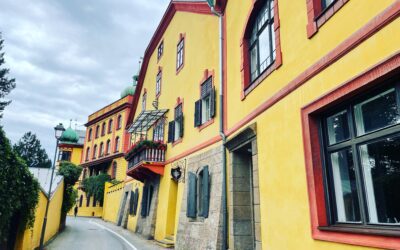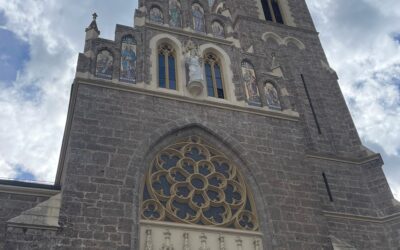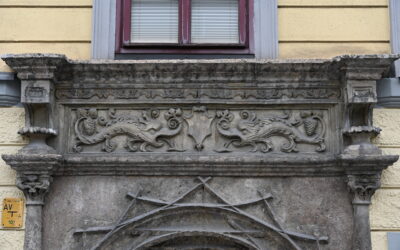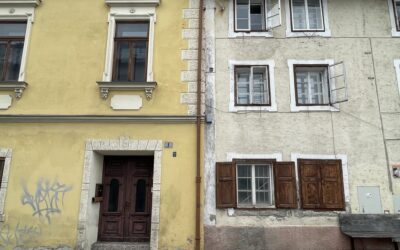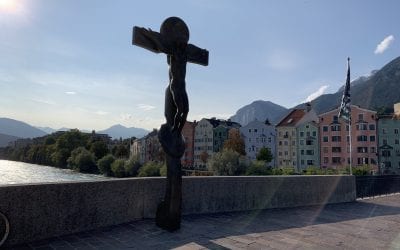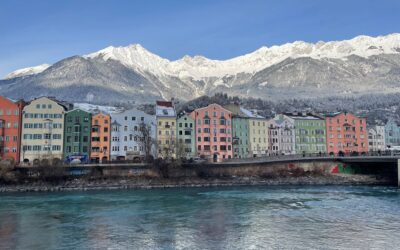St. Nikolaus, Mariahilf, Hötting and Mühlau
Things to know about St Nicholas & Mariahilf
If you like, Innsbruck began in the 12th century with the colourful houses on the northern bank of the Inn. In 1133, the princes of Andechs founded a market in what are now the neighbourhoods of Mariahilf and St. Nikolaus, which is mentioned in documents as Innspruke or Ynbruggen sprach. Als die Stadt über den Inn siedelte, etablierte sich für die Teile nördlich der Brücke der Name Anpruggen. Anders als in der bäuerlichen Umgebung oder der von Fernhändlern, Beamten, Bankiers und Angehörigen des Hofstaats geprägten Stadt innerhalb der Mauern und der Neustadt südlich davon siedelten sich hier Fuhrwerker, Flößer, Arbeiter, Handwerker wie Schmiede und Gastwirte an, um den Durchzugsverkehr zu servicieren und finanziell zu nutzen. Die Siedlung entstand nicht nach und nach aus einem Dorf, sondern zielgerichtet entlang des Verkehrsweges bei der Innbrücke. Dank ihr war Anpruggen ein wichtiger Knotenpunkt für den Handelsverkehr. Lange Zeit führte die Straße nach Westen über die heutige Schneeburggasse in Hötting, da der Landstrich im Tal, der heute die Höttinger Au ist, ein Sumpfgebiet war. Die Mariahilfstraße am Inn wurde erst mit dem steigenden Handelsverkehr im 16. Jahrhundert als Hauptverkehrsweg erschlossen, nachdem Ferdinand II. die Kranewitter Allee hatte anlegen lassen. Silber aus Schwaz und Salz aus Hall wurden über die Salzstraße Richtung Schweiz gehandelt. Bis 1837 war die Hauptstraße durch die Obere Anpruggen officially as Obere Innbrückenstraße known. It was given the name Mariahilfstraße by the parish of the same name. With the opening of the Kettenbrücke bridge in Saggen in the 19th century and the shift towards today's Rennweg and Innrain, Mariahilfstraße lost its importance as an arterial road.
Die Transportwege nach Osten führten direkt durch die heutige St-Nikolaus-Gasse. Das Grätzl galt sehr lange als elender Teil der Stadt. In St. Nikolaus war all das ansässig, was man in der Stadt nicht haben wollte, für das Funktionieren aber notwendig. Hinrichtungsstätten, Armenhäuser und Gefängnisse fanden außerhalb der Mauern ihren Platz. Auch der jüdische Friedhof befand sich in St. Nikolaus am Judenbühel etwas unter dem Alpenzoo. Die unter Maximilian 1485 angelegte Trinkwasserleitung von der Nordkette, die die Innsbrucker Brunnen speiste, verlief durch St. Nikolaus. Innsbruck hatte das große Glück, durch die nahen Berge an frisches Trinkwasser zu kommen. Bis zur Erbauung der Trinkwasserleitung war Innsbruck wie andere Städte vom Wasser in den Brunnen abhängig. Das Wasser war häufig abgestanden und voller Krankheitserreger. Bier und Wein galten nicht umsonst als ungefährlicheres Alltagsgetränk als Wasser. Der Name Koatlackler für seine Anwohner kommt einerseits von den häufig überlaufenden Wasserleitungen, die die Stadt von den Bergen kommend versorgten, andererseits von Überschwemmungen und dem von der Stadt abgeleiteten, verschmutzten Wasser, das flussabwärts in St. Nikolaus landete, eben in der Koatlackn. Einen großen Teil zur Verunreinigung trugen auch die Metzger und die Fleischbank an der Innbrücke bei, die ihre Fleischabfälle im Inn entsorgten, der sie flussabwärts trug. Die Veränderungen des 19. Jahrhunderts beglückten auch St. Nikolaus. Der Warentransport auf dem Inn erhielt den endgültigen Todesstoß. In den 1870er Jahren wurde der letzte Floßabladeplatz der Stadt liquidiert. Stattdessen wurde im Zuge der Flussverbauung der Innpark, der heutige Waltherpark als innerstädtische Grünanlage angelegt. Das älteste Denkmal ist der Joachimsbrunnen, der über mehrere Zwischenstopps von der Altstadt nach St. Nikolaus wanderte. 1877 wurde eine pompöse Statue des mythischen deutsch-tirolischen Minnesängers Walther von der Vogelweide installiert, um die Zuneigung der Stadt zum Germanentum zu manifestieren. Im Jahr darauf folgte die Geographensäule, ein dekorativer Obelisk, der über vieles und nichts Auskunft gibt. Ein weiteres Denkmal aus dem Jahr 1905 erinnert an den Gründer der Freiwilligen Feuerwehr und des organisierten Tiroler Turnsports Franz Thurner. Seinen heutigen Namen erhielt der Waltherpark 1930. Diesmal sollte weniger das Germanentum, als viel mehr die verlorene Landeseinheit Tirols betont werden, die der deutschsprachige Barde symbolisierte. Etwas östlich vom Park wurde 1875 der Kreuzersteg über den Inn eröffnet. Heute ist die mit Liebesschlössern behangene kleine Fachwerkstahlbrücke vor allem pittoreskes Fotomotiv dank dem Hintergrund mit Nordkette und Kirchturm. Nach dem Wegfall der Floßverbindung über den Inn war sie vor dem Automobilverkehr eine wichtige innerstädtische Verkehrsverbindung zwischen Süd- und Nordufer. Trotz dieser neuen Verbindung und Verbürgerlichung konnte sich St. Nikolaus seinen eigenen Charme erhalten. Heute finden sich in den „bunten“ Stadtteilen St. Nikolaus und Mariahilf entlang des Inns viele Kneipen, Lokale und kleine Geschäfte.
Things to know about Hötting
Hötting was a separate village until it was incorporated in 1938. The boundary stone from the 18th century opposite Riedgasse 49 still stands in its place today as a listed building. With 8000 inhabitants, Hötting was one of the largest communities in Tyrol in the 20th century. The Allerheiligenhöfe and the Galgenbühel, next to the Köpflplatz at the eastern entrance to the city in St. Nikolaus, another execution site from days gone by, marked the western end of the community. Successful craft businesses were the reason for the self-confidence with which Höttinger confronted the city of Innsbruck. Economically, the village was on a par with the town for a long time. In the early 16th century, there was already a bathhouse in Hötting. It was only with the development of the new district of Saggen and the incorporation of Pradl and Wilten that Innsbruck finally overtook its often noisy neighbour from above. The people of Hötting were always regarded as wild fellows. Höttinger children were considered bad company for Innsbruck's offspring. In 1923, the newspaper reported:
"Recently, two pistols were taken from a 14-year-old boy in Schneeburggasse, with which he had allegedly amused himself by shooting sparrows. Shortly before, the dog of the tradesman Inwinkel had been shot in the square. The bullet penetrated the animal's head. As many children were playing in the square, it was fortunate that the shooting did not cause any major damage. The case is likely to have legal repercussions."
During industrialisation, workers from factories such as the Rauchmühle also settled in the village of Hötting. In contrast to the city with its employees in trade and administration, university professors, doctors and lawyers, craftsmen, gunsmiths, farmers and workers from the mine under the Hungerburg have always lived here. In the politically radical and heated climate of the interwar period, the village above Innsbruck was known as "Red Hötting". The Höttinger Saalschlacht of 1932, which enjoyed a legendary reputation in Innsbruck, also contributed to the neighbourhood's reputation as a hotbed of violence.
Things to know about Mühlau
Neighbouring Mühlau to the east was a separate municipality until 1938 and, like Hötting, was known for its historically grown industry. The name and significance of the village originate from the farms and mills that had already settled along the Mühlbach stream in the Middle Ages. It was also this energy-supplying stream that helped Mühlau to experience its first industrial boom. A Sagmeister was first mentioned in 1312. In the 15th century, a plater's workshop producing ornate ceremonial armour was established to supply the European aristocracy that had settled in Innsbruck. This was later followed by a metal foundry and, for a short time, even the provincial mint. Between 1567 and 1571, official means of payment were produced from Schwaz silver at the Grabenstein residence using the modern minting machine. In the second wave of industrialisation in the 19th century, the Rauchmühle mill and power station, a sugar factory, a paper factory and the Weyrers and Baurs textile factories were built on the Mühlbach stream and left their mark on the municipality. On the village square in Mühlau, the village fountain with the mill wheel and an interesting relief by Johannes Obleitner are reminders of the connection between rural and industrial life in the village. At Holzgasse 10, you can admire the old power station of the municipality of Mühlau.
The western part of Mühlau along Holzgasse and Richardsweg is home to some of Innsbruck's most beautiful farmhouses and villas. Elevated above the town, the lesser nobility had a series of residences built, which were later adopted by the upper middle classes. Perhaps the most beautiful example of this is the mansion renovated in 1904. Residence Sonnenheim on Richardsweg. The striking Tyrolean-style villa still resembles a castle thanks to its tower. The façades feature paintings by the famous Pradl painter Raphael Thaler.
For some time, Mühlau was also the site of a spa centre. What would be unthinkable today worked in 19th century Innsbruck. A few metres from the textile factory was the Badehaus Mühlau, a spa hotel. Innsbruck was now well connected to the railway network and easily accessible for guests. The mountain panorama that guests enjoyed exuded alpine charm and, unlike in remote places such as Davos, allowed travellers and their companions who were not exclusively interested in health to enjoy a little urban distraction between treatments, as was reported in the magazine Der Alpenfreund in 1870:
"But if the alpine lover is blessed with a family, there is no need to worry about the possible nervous conditions and seizures of his dear wife or the scrophulic ailments of one of his children to prevent him from breathing out all the worries and cares and complaints of business life in the nearby mountains. He just takes his loved ones with him to Mühlau, leaves the healing confidently to the care of the owner of the aforementioned establishment, Dr Schlechter, who will know how to achieve his healing purposes with cold water cures, brine baths, gymnastics and electro-magnetism, and - walk confidently towards heaven on the mountains himself! (Note: quoted from sagen.at)"
Today, the Mühlau bathhouse at Anton-Rauch-Straße 30 is a residential building worth seeing that has been architecturally preserved in the style of the 19th century. Today, Hötting and Mühlau are middle-class neighbourhoods where neither magnetic treatments are administered nor subversive dangers threaten.
Old & New Hötting Parish Church / Plague Cemetery
Schulgasse / Schneeburggasse
Hungerburg
High Innsbruck
Aviary & Pavilion Villa Blanka
Weiherburggasse 31
Pfarre Mariahilf
Dr.-Sigismund-Epp-Weg
Theresienkirche
Gramartstraße 4
Weiherburg & Alpine Zoo
Weiherburggasse 37-39
Turnus clubhouse
Innstraße 2
Büchsenhausen Castle
Weiherburggasse 3-13
St Nicholas Church & Cemetery
Schmelzergasse 1
Gasthaus Elephant & Gasthof zur Eiche
Innstraße 85 / 87
Workers' housing & Weyrer area
Ferdinand-Weyrer-Straße
Inn bridge
Innstraße 5 / Innrain 1
Mariahilfzeile & Marketplace
Mariahilfstraße / Marketplace
